Lessico
Delo
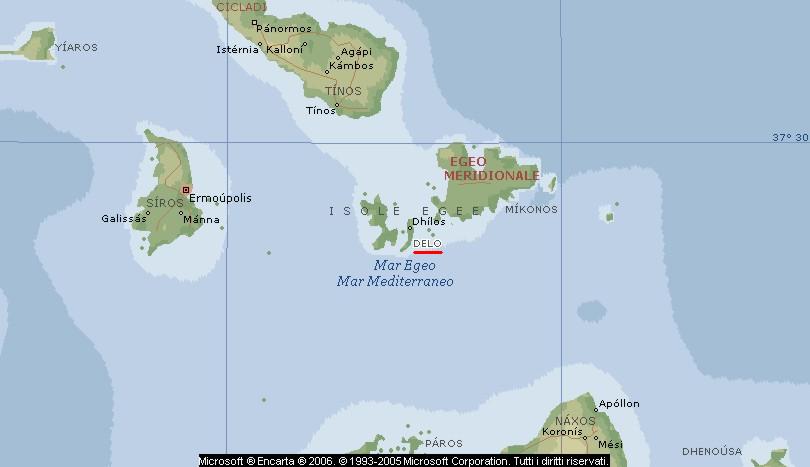
In greco Dêlos. Isola greca (3,43 km2; 16 abitanti)
del Mar Egeo, nell'arcipelago delle Cicladi, tra Micono a est e Rinia a ovest.
Molto piccola e molto arida, non avrebbe mai avuto
un ruolo nella storia se dalla più lontana antichità non fosse stata sacra
ad Apollo![]() e Artemide
e Artemide![]() .
.
Secondo le tradizioni mitologiche, Posidone la fece uscire dalle
acque affinché Latona![]() ,
perseguitata per terra e per mare dalla gelosia di Era
,
perseguitata per terra e per mare dalla gelosia di Era![]() , trovasse infine un
asilo in cui poter mettere al mondo i gemelli Artemide e Apollo. Perciò alle
donne era proibito partorire in quest’isola sacra e non vi si potevano
neppure sotterrare i morti, che venivano trasportati nella vicina isola di
Rinia.
, trovasse infine un
asilo in cui poter mettere al mondo i gemelli Artemide e Apollo. Perciò alle
donne era proibito partorire in quest’isola sacra e non vi si potevano
neppure sotterrare i morti, che venivano trasportati nella vicina isola di
Rinia.
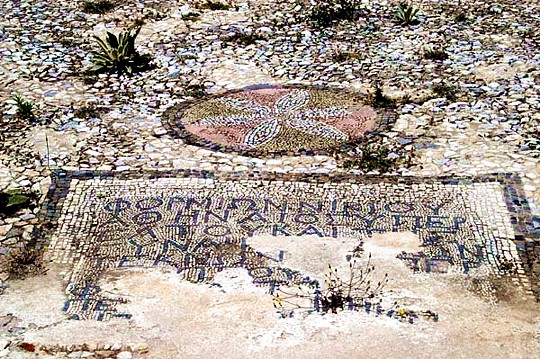
Sulla costa occidentale dell’isola si trovava la città di Delo, sede di un celebre oracolo di Apollo. Ogni quattro anni gli Ateniesi inviavano a Delo una teoria, o deputazione sacra. Grazie alla propria funzione religiosa, presto Delo acquistò grande importanza commerciale. Già nel IX sec. aC le feste di Apollo riunivano a Delo Greci venuti da tutta la Ionia e nel Vl sec. aC raggiunsero il loro apogeo. Nel V sec. aC Atene sfruttò il prestigio religioso di Delo per farne il centro dell’omonima confederazione.
Delo rimase nell’orbita ateniese fin verso il 325 aC, per
ridiventare indipendente nell’epoca macedone, quando fu retta a
repubblica democratica e protetta dai sovrani di Macedonia, divenendo
magazzino di cereali. Roma la restituì ad Atene nel 166 aC, ma con i
privilegi commerciali Delo conservò la propria prosperità: ïl suo porto
franco attirava commercianti da tutto il Mediterraneo. Saccheggiata da
Mitridate VI![]() nell’87 aC e poi devastata dai pirati, entrò in rapido declino.
nell’87 aC e poi devastata dai pirati, entrò in rapido declino.
Delo
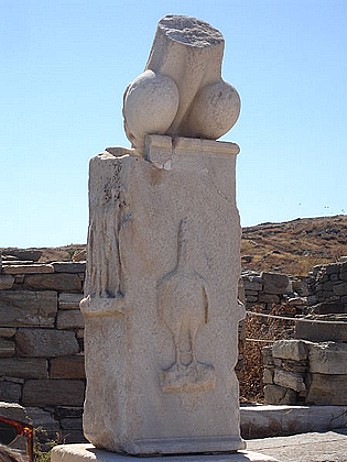
Santuario
di Dioniso a Delo – Fallo monumentale simbolo di Dioniso che risale a
circa il 300 aC, accompagnato dal gallo, forse già a quei tempi considerato
simbolo di elevata attività sessuale, in quanto si accoppierebbe 30 volte al
giorno, al fine di garantire un adeguato apporto di spermatozoi vitali
all'uovo giornaliero di ciascuna gallina del suo harem. Per cui gli Inglesi
forse sono stati ispirati dai Greci quando in gergo battezzarono il pene con
cock, il gallo. Ma non solo gli Inglesi: si veda chi battezzò il pene con il
gallo ricorrendo a kir, kar, kur![]() .
.
Delo è un'isola di 3,4 km² della Grecia, nel Mar Egeo. Fa parte dell'arcipelago delle Cicladi ed è situata vicino all'isola di Mýkonos dalla quale è raggiungibile tramite battelli. L'isola è oggi praticamente disabitata ed è un immenso sito archeologico che richiama turisti e appassionati di archeologia da ogni parte del mondo. È inserita nell'elenco dei patrimoni dell'umanità dell'unesco. Un piccolo stretto separa Delo dalla vicina isola di Rinia, ugualmente disabitata.
Nell'antichità l'isola si chiamava Ortigia (Ortyghía). I reperti archeologici hanno dimostrato che l'isola era già abitata fin dal 3000 aC. I coloni dell'isola (circa nel 1000 aC) probabilmente vi portarono il culto di Apollo, dio della luce e della musica. Nel III e nel II secolo aC fu una città-stato indipendente. Decadde dopo il saccheggio di Mitridate VI re del Ponto (87 aC), i suoi monumenti vennero distrutti e gli abitanti (circa 20.000) vennero uccisi. Fu sotto l'influsso della città di Atene dal VI secolo al IV secolo aC. Fu sede della Lega di Delo (o Lega delio-attica) dal 478 fino al 454 aC.
Dal 1872 la Scuola Archeologica Francese iniziò nell'isola scavi sistematici che ancora oggi continuano. L'isola può definirsi un'immensa area archeologica, a cominciare dalla parte occidentale, dove nell'antichità si trovava il porto sacro. Risale all'VIII secolo uno degli esempi più antichi di molo di protezione, rappresentato da una poderosa struttura in blocchi di granito locale che si estende per circa 100 m.
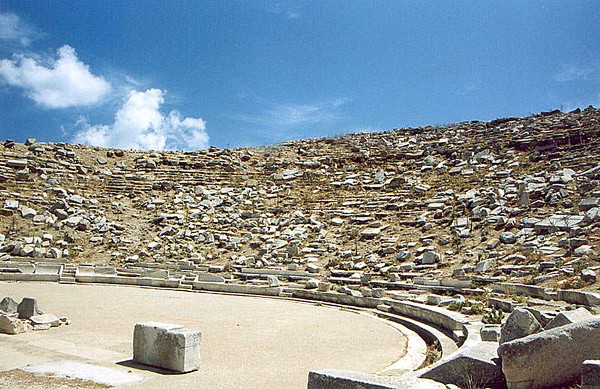
Il teatro
Nella parte nord-occidentale si trovano i Propilei e l'Agorà dei Compitaliasti o Ermesiasti fondata nel II secolo aC e veniva usata dai commercianti romani e dai liberti i quali vi si radunavano e onoravano i Lares Compitales, cioè le divinità dei crocicchi; subito dopo, la Via Sacra con le basi degli ex voto. A ovest c'era la grande Stoà di Filippo, costruita intorno al 210 aC. Nella parte opposta c'è il cosiddetto Portico Sud (III secolo aC) e l'Agorà Sud o Agorà dei Delii. Il santuario di Apollo si trovava a nord-est della Stoà di Filippo insieme a tre templi dedicati al dio, il terzo dei quali, di cui si conservano le fondazioni, è noto come Tempio degli Ateniesi.
Nelle vicinanze, un po' prima del tempio di Apollo, si trova la Casa dei Nassi (metà del VI sec. aC), a nord l'altare Keraton e a nord-est di esso il tempio di Artemide (II secolo aC), costruito sui ruderi di un tempio precedente. Nella parte nord del tempio si trovano i cosiddetti "Tesori" e a est di essi il Prytaneion (metà del V secolo aC) e a ovest il monumento del toro (IV-III sec. aC). A sud-est del monumento, l'altare di Zeus Salvatore protettore dei marinai e a nord il tempio di Dionisio (inizi III sec.) e il portico che si dice sia stato fondato da Antigono Gonata alla fine del III sec. aC.
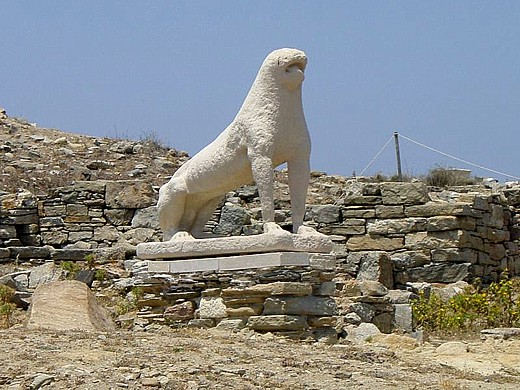
Via dei Leoni
Nella parte ovest c'erano vari edifici: l'Ekklesiasterion, luogo di riunione della Bulè e del Demos dei Delii ed il Tesmoforion, costruzione del V secolo, collegato al culto di Demetra. Nella parte nord del santuario, nel quartiere del lago si trovava l'Agorà di Teofrasto, il santuario dei dodici Dei dell'Olimpo, il tempio di Latona e l'Agorà degli italiani. Dal tempio di Latona, a nord del Lago Sacro, una strada portava alla famosa Via dei Leoni, ex-voto dei Nessi del VII sec. aC, consistente in 9 leoni di marmo dei quali se ne conservano solo cinque. Un po' più in basso si trovava il lago sacro dove, nell'antichità, nuotavano i cigni di Apollo, coperto con terra nel 1926 dopo un'epidemia di malaria.
A nord-ovest della Via dei Leoni si trovava la sede dei Poseidoniasti di Beirut, centro di commercianti che adoravano Poseidone, due palestre, il santuario dell'Archegeta, il Ginnasio e lo Stadio. Il quartiere più abitato era quello del Teatro. Molte sono le abitazioni di età ellenistica e romana ornate con mosaici, i pavimenti musivi: Casa dei Delfini, Casa delle Maschere, Casa del Tridente, Casa di Dionisio. Da questo punto si può arrivare al museo che custodisce reperti degli scavi dell'isola.
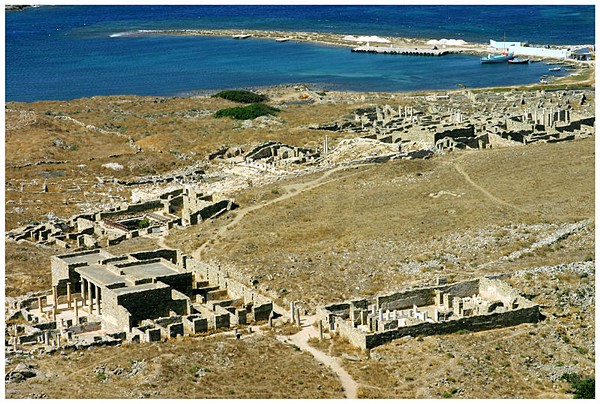
A sinistra la Casa delle Maschere
A Nord-Ovest della Casa delle Maschere si conservano le vestigia del Teatro che aveva una capienza di 5.500 posti, costruzione del II sec. aC. Troviamo inoltre nel Monte Cinto (Kynthos) resti del santuario di Zeus del Cinto e quello di Atena del Cinto.
Secondo la mitologia greca vi si rifugiò Latona per partorire lontano dall'ira di Era. È pertanto considerata il luogo di nascita del dio Apollo e della dea Artemide, figli di Latona. Asteria, figlia della titanide Febe e del titano Ceo, fu la sposa del titano Perse, e gli diede una figlia che chiamarono Ecate. Per sfuggire all'amore fedifrago di Zeus, Asteria si trasformò in una quaglia, ma la fuga frettolosa la fece precipitare nel mar Egeo, come un astro (appunto Asteria). Zeus ne fu addolorato e trasformò Asteria in un'isola, che si chiama anche Ortigia, ovvero "isola delle quaglie". Su quest'isola Leto (sorella di Asterio) trovò asilo e vi partorì Apollo e Artemide. E siccome per la nascita di Apollo, dio del Sole, l'isola fu tutta circonfusa di luce, da allora, fu chiamata Delo, dal verbo greco dëlóø che significa mostrare, poiché era ormai visibile.

The house of Cleopatra
The island of Delos, isolated in the centre of the roughly circular ring of islands called the Cyclades, near Mykonos, is one of the most important mythological, historical and archaeological sites in Greece. The 2001 Greek census reported a population of 14 inhabitants on the island. The island is administratively a part of the municipality of Mýkonos. The excavations in the island are among the most extensive in the Mediterranean; ongoing work takes place under the direction of the French School at Athens. Delos had a position as a holy sanctuary for a millennium before Olympian Greek mythology made it the birthplace of Apollo and Artemis. From its Sacred Harbour, the horizon shows the two conical mounds that have identified landscapes sacred to a goddess in other sites: one, retaining its archaic name Mount Kynthos, is crowned with a sanctuary of Dionysus.
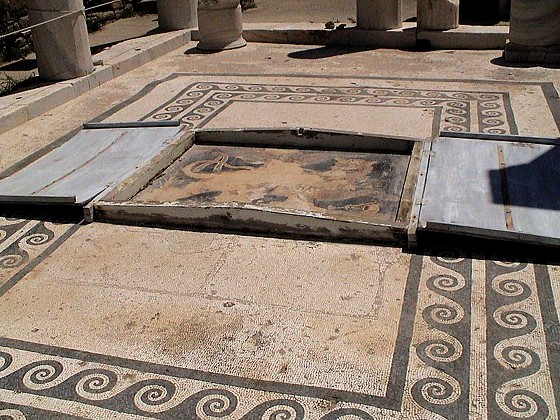
House of Dionysus
Established as a cult centre, Delos had an importance that its natural resources could never have offered. In this vein Leto, searching for a birthing-place for Apollo, addressed the island: Delos, if you would be willing to be the abode of my son Phoebus Apollo and make him a rich temple --; for no other will touch you, as you will find: and I think you will never be rich in oxen and sheep, nor bear vintage nor yet produce plants abundantly. But if you have the temple of far-shooting Apollo, all men will bring you hecatombs and gather here, and incessant savour of rich sacrifice will always arise, and you will feed those who dwell in you from the hand of strangers; for truly your own soil is not rich. (Homeric Hymn to Delian Apollo)
Investigation of ancient stone huts found on the island indicate that it has been inhabited since the 3rd millennium BC. Thucydides identifies the original inhabitants as piratical Carians who were eventually expelled by King Minos of Crete. By the time of the Odyssey the island was already famous as the birthplace of the twin gods Apollo and Artemis (although there seems to be some confusion of Artemis' birthplace being either Delos or the island of Ortygia). Indeed between 900 BC and AD 100, sacred Delos was a major cult centre, where Dionysus is also in evidence as well as the Titaness Leto, mother of the above mentioned twin deities.
A number of "purifications" were executed by the city-state of Athens in an attempt to render the island fit for the proper worship of the Gods. The first took place in the 6th century BC, directed by the tyrant Pisistratus who ordered that all graves within sight of the temple be dug up and the bodies moved to another nearby island. In the 5th century, during the 6th year of the Peloponnesian war and under instruction from the Delphic Oracle, the entire island was purged of all dead bodies. It was then ordered that no one should be allowed to either die or give birth on the island due to its sacred importance and to preserve its neutrality in commerce, since no one could then claim ownership through inheritance. Immediately after this purification, the first quinquennial festival of the Delian games were celebrated there.
After the Persian wars the island became the natural meeting-ground for the Delian League, founded in 478 BC, the congresses being held in the temple (a separate quarter was reserved for foreigners and the sanctuaries of foreign deities). The League's common treasury was kept here as well until 454 BC when Pericles removed it to Athens.
Since 1873 the École Française d'Athènes ("French School of Athens") has been excavating the island, the complex of buildings of which compares with those of Delphi and Olympia. The island had no productive capacity for food, fiber, or timber, with such being imported. Limited water was exploited with an extensive cistern and aqueduct system, wells, and sanitary drains. Various regions operated agoras (markets). The largest slave market in the larger region was also maintained here. In 1990, unesco inscribed Delos on the World Heritage List, citing it as the "exceptionally extensive and rich" archaeological site which "conveys the image of a great cosmopolitan Mediterranean port".
The Minoan Fountain was a rectangular public well hewn in the rock, with a central column; it formalized the sacred spring in its present 6th century BC form, reconstructed in 166 BC, according to an inscription. Tightly-laid courses of masonry form the walls; water can still be reached by a flight of steps that fill one side.
There are several market squares. The Hellenistic Agora of the Competaliasts by the Sacred Harbour retains the postholes for market awnings in its stone paving. Two powerful Italic merchant guilds dedicated statues and columns there.
The Temple of the Delians is a classic example of the Doric order; a pen-and-wash reconstruction of the temple is illustrated at Doric order.
The Terrace of the Lions dedicated to Apollo by the people of Naxos shortly before 600 BC, had originally nine to twelve squatting, snarling marble guardian lions along the Sacred Way; one is inserted over the main gate to the Venetian Arsenal. The lions create a monumental avenue comparable to Egyptian avenues of sphinxes. (There is a Greek sphinx in the Delos Museum.)
The meeting hall of the Poseidoniasts of Beirut housed an association of merchant, warehousemen, shipowners and innkeepers during the early years of Roman hegemony, late 2nd century BC. To their protective triad of Baal/Poseidon, Astarte/Aphrodite and Echmoun/Asklepios, they added Roma.
The platform of the Stoibadeion dedicated to Dionysus bears a statue of the god of wine and the life-force. On either side of the platform, a pillar supports a colossal phallus, the symbol of Dionysus. The southern pillar, which is decorated with relief scenes from the Dionysiac circle, was erected ca. 300 BC to celebrate a winning theatrical performance. The statue of Dionysus was originally flanked by those of two actors impersonating Paposilenoi (conserved in the Delos Museum). The marble theatre is a rebuilding of an older one, undertaken shortly after 300 BC.
The Doric Temple of Isis was built on a high over-looking hill at the beginning of the Roman period to venerate the familiar trinity of Isis, the Alexandrian Serapis and Anubis.
The Temple of Hera, ca 500 BC, is a rebuilding of an earlier Heraion on the site.
The House of Dionysus is a luxurious 2nd century private house named for the floor mosaic of Dionysus riding a panther.
The House of the Dolphins is similarly named from its atrium mosaic, where erotes ride dolphins; its Phoenician owner commissioned a floor mosaic of Tanit in his vestibule.